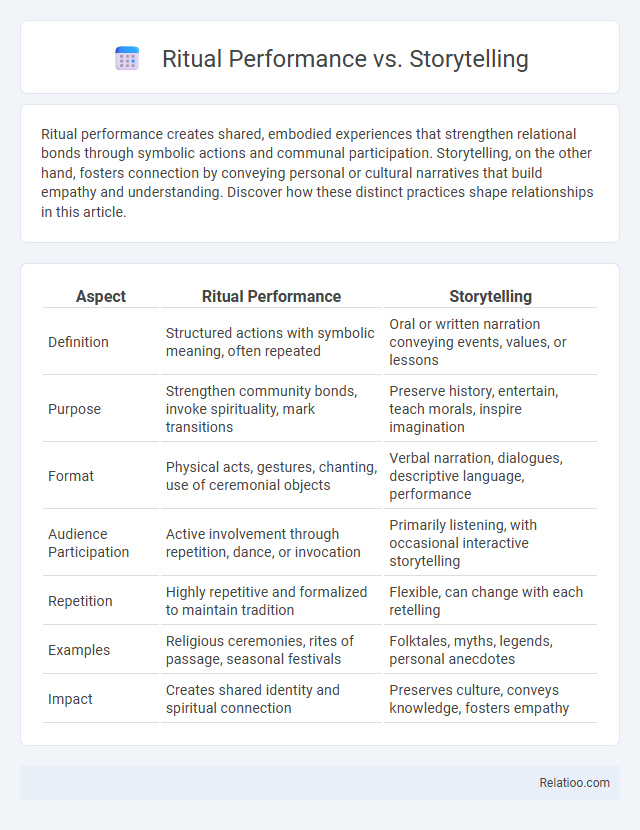Ritual performance creates shared, embodied experiences that strengthen relational bonds through symbolic actions and communal participation. Storytelling, on the other hand, fosters connection by conveying personal or cultural narratives that build empathy and understanding. Discover how these distinct practices shape relationships in this article.
Table of Comparison
| Aspect | Ritual Performance | Storytelling |
|---|---|---|
| Definition | Structured actions with symbolic meaning, often repeated | Oral or written narration conveying events, values, or lessons |
| Purpose | Strengthen community bonds, invoke spirituality, mark transitions | Preserve history, entertain, teach morals, inspire imagination |
| Format | Physical acts, gestures, chanting, use of ceremonial objects | Verbal narration, dialogues, descriptive language, performance |
| Audience Participation | Active involvement through repetition, dance, or invocation | Primarily listening, with occasional interactive storytelling |
| Repetition | Highly repetitive and formalized to maintain tradition | Flexible, can change with each retelling |
| Examples | Religious ceremonies, rites of passage, seasonal festivals | Folktales, myths, legends, personal anecdotes |
| Impact | Creates shared identity and spiritual connection | Preserves culture, conveys knowledge, fosters empathy |
Defining Ritual Performance and Storytelling
Ritual performance involves structured, symbolic actions performed in a specific sequence to convey cultural or spiritual meanings, often serving communal or ceremonial purposes. Storytelling, by contrast, centers on narrating events or experiences using language, voice, and sometimes gestures to engage an audience emotionally and intellectually. Understanding the distinction helps refine your approach to communication, emphasizing ritual's formal symbolism versus storytelling's narrative creativity.
Historical Origins and Cultural Context
Ritual performance, rooted in ancient religious and communal ceremonies, serves as a symbolic act embodying cultural beliefs and societal values, often predating formal storytelling traditions. Storytelling, emerging from oral histories and myths, functions as a medium to transmit cultural knowledge, moral lessons, and historical events across generations. Understanding the historical origins and cultural context of these practices enhances Your appreciation of how rituals and narratives shape collective identity and societal continuity.
Purpose and Function in Societies
Ritual performance serves as a structured enactment of cultural beliefs, reinforcing social cohesion and collective identity through symbolic actions. Storytelling functions to transmit knowledge, values, and history, shaping individual and communal understanding across generations. While ritual performance emphasizes communal participation and spiritual or social order, storytelling prioritizes narrative engagement and the preservation of cultural memory.
Structure and Elements of Rituals
Ritual performance is characterized by a highly structured sequence of symbolic actions, gestures, and expressions designed to evoke specific cultural meanings, contrasting with storytelling's narrative-driven format focused on plot and characters. Rituals incorporate elements such as prescribed roles, sacred objects, repetitive patterns, and timed ceremonies that create a communal and transformative experience. These structural components differentiate rituals from the fluid, often open-ended dynamics of storytelling, emphasizing collective participation and symbolic enactment over narrative exposition.
Narrative Techniques in Storytelling
Narrative techniques in storytelling involve structured plot development, character arcs, and thematic exploration to engage audiences through a primarily verbal and imaginative experience. Ritual performance emphasizes repetitive, symbolic actions and sensory elements designed to evoke communal participation and spiritual meaning beyond narrative logic. While storytelling weaves complex narratives using literary devices, ritual performance prioritizes embodied expressions and cultural traditions to communicate shared values and identity.
Audience Engagement and Participation
Ritual performance deeply immerses Your audience through symbolic actions and shared cultural meanings, fostering active participation and emotional connection. Storytelling captivates listeners by weaving narratives that stimulate imagination and empathy, but often limits direct interaction to auditory engagement. Combining storytelling with ritual performance amplifies audience involvement, blending narrative comprehension with embodied experiences for heightened engagement.
Emotional and Psychological Impact
Ritual performance deeply engages your emotions through repetitive symbolic actions that foster a sense of community and belonging, creating lasting psychological connections. Storytelling captivates by evoking empathy and imagination, allowing you to experience diverse perspectives and emotions vicariously. While storytelling uses narrative structure to stimulate cognitive reflection, ritual performance emphasizes embodied experience, both profoundly shaping emotional and psychological states.
Modes of Transmission and Preservation
Ritual performance transmits cultural knowledge through embodied practices and sensory engagement, embedding tradition within communal actions that enhance collective memory. Storytelling relies on verbal narration and mnemonic structures to preserve history and values across generations, often adapting content to contemporary contexts while maintaining core meanings. Your understanding deepens by recognizing that ritual performance emphasizes participatory preservation, whereas storytelling prioritizes oral transmission, both crucial for sustaining cultural heritage.
Intersections and Overlaps: When Rituals Tell Stories
Ritual performance and storytelling intersect deeply when rituals serve as mediums to convey cultural narratives, blending symbolic actions with narrative elements to preserve collective memory. Your participation in ritualistic storytelling enriches understanding by engaging multiple senses, creating immersive experiences that reinforce shared values and identities. These overlaps highlight the fluid boundary where performative actions simultaneously function as dynamic stories, sustaining tradition through enactment and verbal expression.
Evolving Roles in Contemporary Culture
Ritual performance, storytelling, and storytelling increasingly intertwine in contemporary culture, reflecting evolving roles that blend tradition with innovation. Ritual performance preserves cultural identity through symbolic acts, while storytelling adapts narratives to modern contexts, fostering community engagement and shared memory. This dynamic interplay highlights how both forms serve as vital mechanisms for cultural expression and societal cohesion in a rapidly changing world.

Infographic: Ritual Performance vs Storytelling
 relatioo.com
relatioo.com